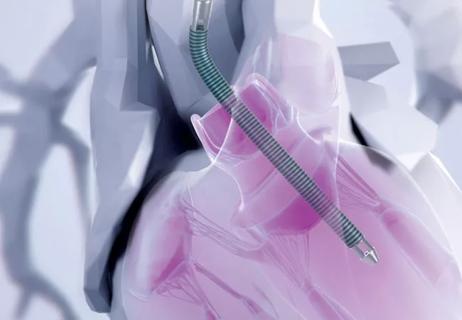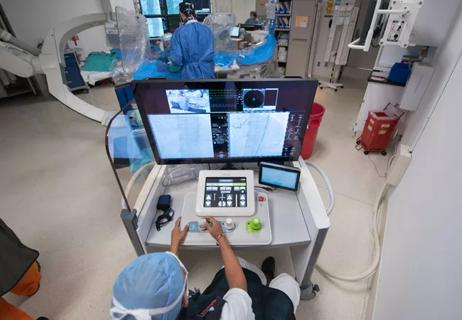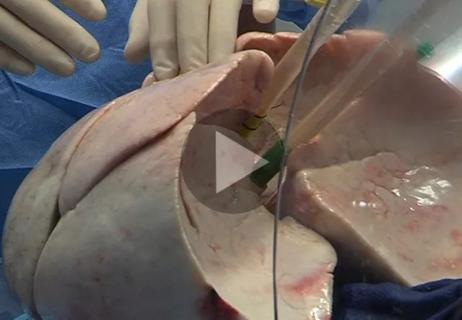Patient-patient network analysis proves to be fast and clinically intuitive

A machine learning technique using network clustering has been developed to assess risk of cardiac-related morbidity and mortality in oncology patients. The tool also identified serum levels of NT-proB-type natriuretic peptide (NT-proBNP) and troponin T as biomarkers associated with risk, offering an opportunity to recognize and target high-risk patients with appropriate preventive interventions.
Advertisement
Cleveland Clinic is a non-profit academic medical center. Advertising on our site helps support our mission. We do not endorse non-Cleveland Clinic products or services. Policy
This methodology and findings from analysis of data from thousands of Cleveland Clinic cancer patients with up to 20 years of follow-up were described in a recent article in PLOS Medicine.
“Our network clustering method allows rapid and clinically intuitive stratification of cardiac risk in cancer survivors,” says the study’s co-corresponding author, Patrick Collier, MD, PhD, Co-Director of Cleveland Clinic’s Cardio-Oncology Center. “It promises to help identify patients at risk and clinically actionable factors for advancing precision medicine in cardio-oncology.”
While advances in cancer therapy continue to improve cancer outcomes, many patients face mounting cardiac risk from their lifesaving therapy, as cardiovascular effects have been demonstrated with radiotherapy, cytotoxic chemotherapy, targeted therapies and immunotherapy. Growing awareness of cancer therapy-associated cardiac dysfunction has launched the subspecialty of cardio-oncology, but little is understood about the impacts of the multiple variables involved, making risk assessment difficult.
Advances in artificial intelligence (AI) and network science technologies have enabled the development of tools to derive clinically useful information from large data sets and many variables. In the current Cleveland Clinic study, a method was employed called patient-patient similarity network-based risk assessment of cardiovascular disease that allows for patients of unknown risk status to be classified based on their similarity to patients with known risk status.
Advertisement
The study was based on a cohort of 4,632 cancer patients referred to Cleveland Clinic’s cardio-oncology service between March 1997 and January 2019. All had at least one of the following diagnosed cardiac outcomes: atrial fibrillation, coronary artery disease, heart failure, myocardial infarction or stroke. Patients were further categorized as having received the cardiac diagnosis before or after cancer therapy was initiated. Median patient age was 63 years (interquartile range, 54-71).
In addition to patient demographics, the analysis accounted for cancer type and stage, treatment type, laboratory test results, cardiac factors and more than 25,000 echocardiograms.
Analysis of the data with patient-patient similarity network clusters identified four clinically relevant subgroups of patients that were statistically significantly correlated with incidence of poor cardiac outcomes and mortality.
One subgroup had the highest risk of de novo cancer-therapy-related cardiac dysfunction (hazard ratio = 3.05; 95% CI, 2.51-3.72). Patients in this group had a higher risk of mortality within five years after initiating cancer therapies compared with long-term risk (i.e., 6-20 years).
“Our analysis determined that mortality was more likely within two to five years after the initiation of cancer therapy,” notes Feixiong Cheng, PhD, the study’s other corresponding author and a researcher in Cleveland Clinic’s Genomic Medicine Institute. “This underscores the vital role of early cardiac care in improving the survival of cancer patients.”
Advertisement
In addition, clinical variable network analysis showed that mortality was significantly correlated with serum levels of two well-established biomarkers for heart disease:
“Identification of clinically relevant predictors like these offers actionable biomarkers for rapid risk assessment that may ultimately promote early risk stratification in cardio-oncology practice,” says Dr. Collier.
The study is the latest in a series from this team of investigators as they have developed the AI method using the longitudinal Cleveland Clinic cancer database and applied it to issues in cardio-oncology.
In a paper published in the American Journal of Cardiology (2020 Dec 15;137:118-124), they detailed temporal trends of cardiovascular disease in oncology patients, finding that mortality and diagnosis of clinical cardiac disease peaked around the time of chemotherapy.
Another study (Open Heart. 2020 Nov;7[2]:e001412) focused on the relationship between atrial fibrillation and cancer. It found that a first diagnosis of atrial fibrillation among cancer patients was more common in older patients and those exposed to cardiotoxic treatment, and that it was associated with a poor prognosis.
A third study, published in the Journal of the American Heart Association (2020 Dec;9(23):e019628), demonstrated for the first time that a large-scale machine learning-based approach provides an accurate and generalizable assessment of patient risk for cancer therapy-related cardiac dysfunction (as summarized previously on Consult QD).
Advertisement
The current study extends this previous work and identifies clinically relevant subgroups correlated with incidence of cardiac outcomes. It also found two biomarkers associated with patient mortality, although the researchers note that further validation is needed before these can be introduced in clinical practice.
“Altogether, our findings indicate that, compared with traditional risk models, our patient-patient similarity network methodology is clinically intuitive and excels at integrating large-scale, heterogeneous patient data to stratify cardiac dysfunction risk in cancer patients,” observes Dr. Cheng. “As a next step, we will be developing new risk calculators that integrate our AI models into Cleveland Clinic’s electronic health record system to improve cardiovascular care for cancer patients.”
Advertisement
Advertisement

How we’re using a new multidisciplinary approach to broaden the benefits of ablation

Models developed with promising accuracy and generalizability to clinical practice

Illustrated case series profiles a valuable tool for a rare and complex entity

A minimally invasive, single-incision approach to two coexisting problems

A long-overdue technology is poised to reshape practice

A short video portrait and overview of our experience to date

A glimpse into our centralized monitoring strategy and more

Its roots run deep, and its reach keeps growing